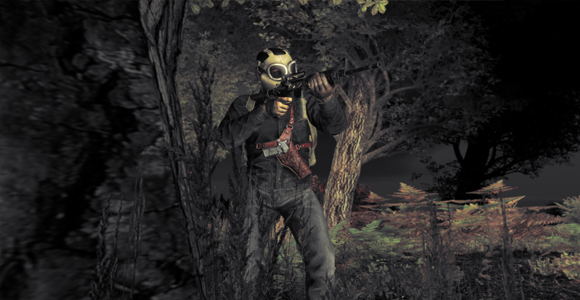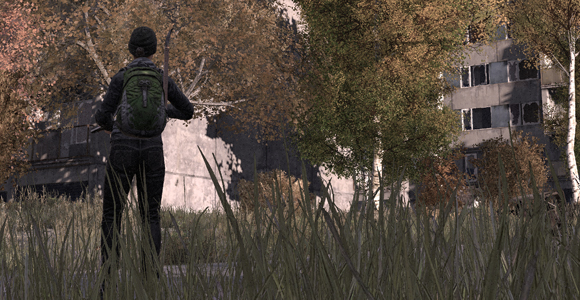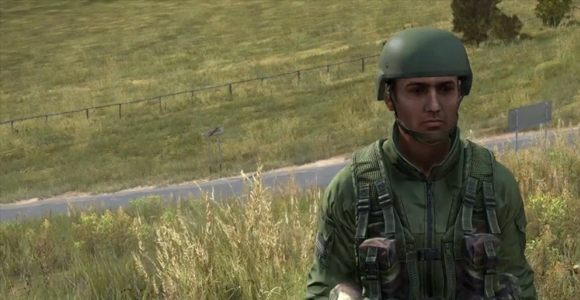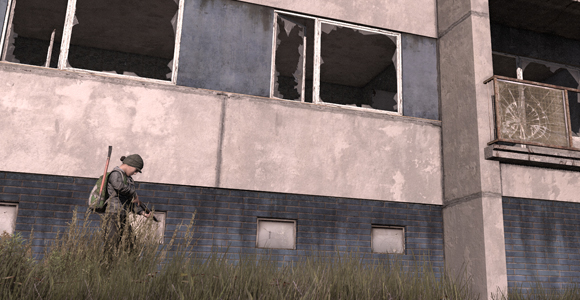
Clothes maketh the man -- or the bandit.
By r3volution on March 3, 2014 at 8:35 am
Welcome back to another Community Soapbox article! If you’ve got something you’d like to say to our community, check here for more information about how to get your thoughts up in lights.
***
In the weeks since the DayZ standalone alpha has been released there’s been a hugely reinvigorated (and justified) groundswell of interest in the game. I’m not going to spend much time trying to explain the game to those who’ve never heard of it, beyond describing it as an open world, rogue-like multiplayer post -zombie-apocalyptic survival game and suggesting you read any of the two billion well-written articles explaining it. Suffice to say that the chief form of tension, amusement and camaraderie revolves around a player’s interactions with other players, which are more or less (within the confines of a game) unfettered by any game-based rules.
Meet new people and go on adventures? Check.
Meet new people, handcuff them and feed them disinfectant while your three pants-less friends wander around waving their arms in the air and rocking from side to side? Check!
Shoot new people before you meet them? Check.
Wander around an abandoned chunk of eastern European countryside leaving disturbing notes for other people to find? Check.
So based on that rule of internet (freedom from repercussion?) that says for every interesting sociopath there’s a thousand unimaginatively paranoid ones, a large number of people have limited their human interaction to shooting other players on sight. This has always been a central factor in the game since the early days of the mod, with kill on sight (known as KOS) behaviour anecdotally occurring as soon as the mod servers opened to a larger European player base beyond the testers). A combination of perma-death, the scarcity of equipment and food and the limited means of communication available in a gaming context combine to amplify the tendency towards either killing people to take their gear, or to kill someone else pre-emptively lest they kill you and take yours.

This behaviour in and of itself is not too interesting or exceptional; it’s just a representation of our more unsavoury evolutionary traits like xenophobia and paranoia, unmoderated by consequence or significant repercussion (internet). What has immediately become far more interesting has been the evolution of responses to this behaviour within the community following the release of the standalone DayZ game.
The DayZ mod had a rudimentary ‘humanity’ system based on killing other players. If you killed people, your player account (including existing and any new characters) would accumulate negative points until you became a ‘bandit.’ Conversely, killing a ‘bandit’ or administering first aid to another player would earn you humanity points.
Out of this system emerged three classes of players: the ‘bandits,’ who had very negative humanity points; the ‘heroes,’ who killed bandits and had very high humanity points; and the ‘survivors,’ encompassing everyone in between. These classes were further reinforced with the introduction ofa ‘bandit’ skin (mixed camo with a shemagh over the face) and a ‘hero’ skin (plaid shirt and jeans), which were given to players who had sufficient negative or positive ‘humanity.’ These skins were just clothing items like any other and could be swapped out for other clothing, but were automatically assigned at player spawn. So while they were optional clothing sets in an absolute sense, opportunities for changes of clothing were limited in mod when compared to the standalone.

This in no way precluded being killed by a ‘bandit’ who had changed into ordinary camo clothing, or by a ‘survivor’ who looked normal but didn’t yet have enough negative humanity to be a ‘bandit’, or even by a ‘hero’ having a bad day. But it has led to an enduring association between player clothing and player intention amongst the DayZ community, which has carried over to the standalone alpha of DayZ.
The standalone DayZ alpha at present lacks any kind of humanity system and does not (to my knowledge) track player interaction with the same consequences that the mod did. In addition, the DayZ alpha adds an entirely new, more modular clothing system with a huge variety of options, varying from unmistakably civilian (jeans and a bright t-shirt or jacket for example) to military (full camouflage gear, military vests/helmets/gas mask). These can be worn in just about any combination imaginable, resulting in a near infinite number of appearances for the player base.
Despite these two massively complicating factors, a significant number of DayZ players have been using clothing choices as one way of attempting to determine another player’s intentions. Other things do factor in, like choice of weapons, but the system seems to be primarily based on clothing, which is the most easily identifiable thing on a player at distance. In this system of judgement the following types of equations seem to be developing in the minds of players:
- Full Camouflage (any type) + Face Mask + Helmet = Bandit
- Full Camouflage + other headgear but no mask = Probably Bandit
- Civilian pants + Plaid Shirt/Civilian Jacket = Probably trustworthy

There are as many variations of this system as there are players, so it is hard to completely categorise, but this broadly sums it up. Ironically, despite the fact that there’s nothing whatsoever to stop a ‘bandit’ type player from wearing civilian clothing and that many ‘hero’ type players wear full camouflage, the system seems to have become fairly widespread amongst players.
Between the collective memory of how the ‘rules’ used to be enforced during the days of the DayZ mod and the lack of any other system to determine the intent of others, players have essentially created their own ‘system’ out of more or less meaningless information. The fact that this system has a built in routine for the justification of killing other players only adds to its psychological attractiveness. Where in the DayZ mod you would know if you had killed a ‘survivor’ or a ‘bandit’, the standalone leaves players in the dark about the player they have killed. So for those playing as a ‘survivor,’ the ability to justify a kill as self-defence rather than murder becomes very psychologically important.
All this creates something of a self-perpetuating nature too, as the more the system becomes known through the player base, the greater the chance will be of more players participating. This can come in the form of ‘survivors’ deciding to wear civilian clothes rather than camouflage to indicate lessened hostility, or ‘bandits’ wearing civilian clothing to lure in victims, or just people justifying their kills on the basis of clothing –either way, the system is being perpetuated.
In the end, the funniest and most interesting thing to me is knowing that in a game which is almost entirely based around human interaction but lacks almost every human behavioural cue, players have created their own system to infer meaning from inherently meaningless information. How far will it go? Who knows, but it’s going to be intriguing to see…